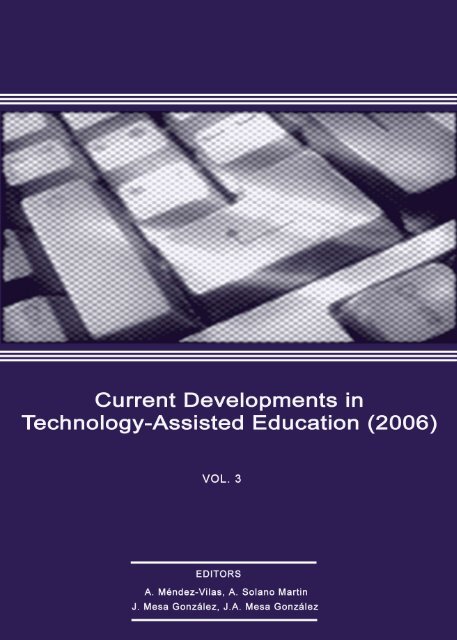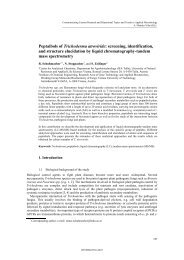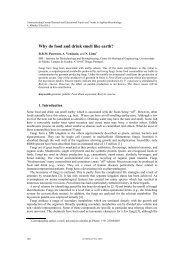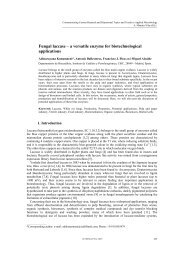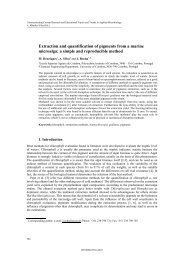Table of Contents - Formatex Research Center
Table of Contents - Formatex Research Center
Table of Contents - Formatex Research Center
Create successful ePaper yourself
Turn your PDF publications into a flip-book with our unique Google optimized e-Paper software.
Current Developments in Technology-Assisted<br />
Education (2006)<br />
Vol. 3
XX<br />
CONTENT VOL. 3<br />
e-LEARNING STANDARDS: LEARNING OBJECTS AND<br />
REPOSITORIES<br />
Adaptive evaluation in an E-Learning System Architecture<br />
J. López-Cuadrado, A. Armendariz and T. A. Pérez………………………………………………… 1507<br />
A distributed platform <strong>of</strong> training <strong>of</strong> data-processing networks based on the web<br />
Souleymane Oumtanaga and L. Jimmy Kouraogo…………………………………………………….. 1512<br />
Arquitectura para la nueva generación de plataformas educativas<br />
Víctor Germán Sánchez Arias, Francisco Cervantes Perez, Fernando Gamboa and Eric<br />
Huesca………………………………………………………………………………………………………. 1519<br />
Complicated Labour: Delivering Inter-pr<strong>of</strong>essional Learning Objects<br />
Elinor Clarke, Rebecca Khanna…………………………………………………………………………. 1524<br />
Dynamic representation <strong>of</strong> knowledge context's structure<br />
P. Frignani, M. Pedroni and G. Poletti…………………………………………………………………. 1529<br />
ELEONET: The search portal for learning objects<br />
Jan Brase, Sergey Chernov and Alvaro Ordóñez……………………………………………………… 1534<br />
ELSI: un editor de LOM sencillo<br />
X. A. Vila, A. Bóo, A. Gewerc, E. Sánchez and M. Lama.............................................................. 1539<br />
Employing Semantic Web methods to provide and use e-learning metadata<br />
Martina Weicht…………………………………………………………………………………………….. 1545<br />
Evaluating Learning Objects for E-Learning: Automatic Correction Filters<br />
Laura Benedetti, M. Vitturini, C. Fernandez Coria and P. Señas…………………………………… 1550<br />
Extensión al secuenciamiento de SCORM para incluir a las simulaciones en los sistemas<br />
de E-learning<br />
A. de Antonio Jiménez, J. Ramírez Rodríguez y Z. Madrigal Alfaro………………………………... 1555<br />
Learning Objectives for E-Learning Instruction<br />
F. Alonso, J. Couchet, D. Manrique and F. J. Soriano……………………………………………….. 1560<br />
Learning paths in open source e-learning environments<br />
D.Tuparova and G.Tuparov………………………………………………………………………………. 1565<br />
Learning strategies and Learning Objects' structural models: how to classify them<br />
M. Pedroni………………………………………………………………………………………………….. 1570<br />
Leveraging open source portal technologies to create successful educative collaboration<br />
communities<br />
Jorge Ferrer, Felipe Retortillo, Carlos A. Iglesias and Jose Ruiz…………………………………... 1575<br />
Mapas Conceptuales Hipermediales y Organización de los Objetos de Aprendizaje<br />
Ana Maguitman, Carolina Fernández Coria and Perla Señas………………………………………. 1580
Merging domain knowledge and task analysis in an ontology<br />
Alexander Staller…………………………………………………………………………………………… 1585<br />
Multimedia: virtual instruction, real learning<br />
G. Poletti……………………………………………………………………………………………………. 1590<br />
Team Enhanced Creativity: An approach to Designing User-Centred Reusable Learning<br />
Objects<br />
John Cook, Debbie Holley, Carl Smith, Richard Haynes and Claire Bradley…………………….. 1595<br />
The role <strong>of</strong> LOs in building teachers communities <strong>of</strong> learning<br />
E. Busetti, G. Dettori, P. Forcheri , , M.G. Ierardi……………………………………………………... 1601<br />
DIGITAL GAMES<br />
A Window to Digital Games Interactions in Informal Settings<br />
E. Gazit ……………………………………………………................................................................... 1609<br />
Business management education – electronic games and gamers as managers<br />
James R. Philips……………………………………………………...................................................... 1615<br />
Investigative games and internet on-line activities<br />
Z. Gálik………………………………………………………………….................................................. 1619<br />
Los juegos informáticos de simulación en la enseñanza de las Ciencias Sociales y<br />
Experimentales<br />
J. M. Cuenca López y M. Ferreras Listán. ……………………………………………………............. 1624<br />
Modelling a market using s<strong>of</strong>tware agents –pedagogical experi-ence in a Distributed<br />
Artificial Intelligence course.<br />
Hugo Gamboa , Bruno Silva, and Joaquim Filpe……………………………………………………... 1630<br />
Playing with the past: the role <strong>of</strong> Digital Games in how we understand History<br />
S. Gómez García…………………………………………………………………………………………… 1635<br />
NATIONAL, REGIONAL AND LOCAL EXPERIENCES<br />
A study on the use <strong>of</strong> s<strong>of</strong>tware applications in the context <strong>of</strong> Engineering Management<br />
education in Spain<br />
E. Ponce, T. Sánchez, A. García and M. Ortega………………………………………………………. 1643<br />
A virtual campus for continuing education in health sciences<br />
E. Rinaldi, C. Dellacasa, S. Monducci, G. Ricci, G. Stabile, F. Rubbi…………………………….. 1648<br />
Benchmarking Access and Use <strong>of</strong> ICT in European Schools 2006: Results from Head<br />
Teacher and A Classroom Teacher Surveys in 27 European Countries<br />
Werner B. Korte, Tobias Hüsing.................................................................................................... 1652<br />
Blended Learning: the practicalities <strong>of</strong> implementation in a UK University<br />
S. Jones and M. Northrop…………………………………………………………………………………. 1658<br />
Centro de innovación educativa (CIE) de la Universidad Veracruzana: Un nuevo<br />
enfoque de enseñanza Universitaria<br />
V. G. Sánchez Arias, A. Reyes Muñoz and R. Parra Loera…………………………………………... 1664<br />
XXI
XXII<br />
Cloze Oriented System (COS) in an electronic comprehension program and reading<br />
attitude in Brazil<br />
M. Cristina R. Azevedo Joly........................................................................................................... 1669<br />
CmL – The first m-learning platform implemented in the Romanian DE system<br />
C. Hutanu, A. Vlaicu, C. Turcu and B. Orza…………………………………………………………… 1675<br />
Comparing information and communication technology performance and reading<br />
achievements <strong>of</strong> high school Brazilian students<br />
M. Cristina R. Azevedo Joly and Ronei Ximenes Martins……………………………………………. 1682<br />
Developing an intensive course for e-learning practitioners in Estonia: design priorities,<br />
delivery strategies and evaluation<br />
M. Mimirinis and M. Bhattacharya……………………………………………………………………… 1688<br />
Educación e identidad a través de las webs de los museos andaluces<br />
J. M. Cuenca López, M. Martín Cáceres y J. Estepa Giménez………………………………………. 1694<br />
Educación, globalización y tecnología: reflexiones sobre el concepto de universidad<br />
tecnológica y su uso en la política educacional brasileña<br />
Domingos Leite Lima Filho………………………………………………………………………………. 1699<br />
El uso del foro virtual como herramienta para favorecer el aprendizaje autónomo y en<br />
grupo del estudiante en titulaciones presenciales adaptadas a las directrices del EEES<br />
M. Fuentes Agustí y C. Guillamón Ramos……………………………………………………………... 1703<br />
Examining the level <strong>of</strong> penetration and impacts <strong>of</strong> internet usage amongst<br />
Undergraduates in Nigerian Universities -a case study approach.<br />
O. Michael Awoleye and O. Willie Siyanbola…………………………………………………………. 1708<br />
ICTs: Teachers’ and students’ preconceptions and the implications for present and<br />
future teacher education<br />
D. Clare, and J. L. Backwell……………………………………………………………………………… 1714<br />
Implementation <strong>of</strong> a Blended Learning Approach: Milestones, Tractors and Crossroads<br />
Mary Northrop and Sarah Jones………………………………………………………………………… 1719<br />
Information and Communication Technologies in Teachers Continuing Education:<br />
Experiences in Andalusia.<br />
L. Marín Trechera, A. Gámez Mellado, R. Rodríguez Huertas and S. Fandiño Patino………….. 1724<br />
New Tecnologies integration in the Open University for elsderly people at the Balearic<br />
Islands<br />
MªA. Manassero Masç, R. Jiménez Rodríguez…………………………………………………………. 1729<br />
Programa de tutorización de las prácticas de los estudiantes de Magisterio de Audición y<br />
Lenguaje a través del campus virtual. Primera experiencia.<br />
Gabriel Díaz Jiménez, José Juan Castro Sánchez, Olga Escandell Bermúdez and Mª del Pilar<br />
Etopa Bitata………………………………………………………………………………………………… 1735<br />
Promoting the use <strong>of</strong> Information Technologies close to General Communities <strong>of</strong><br />
Northeast Portugal<br />
Gina M. M. C. Santos, Maria Gentil A. D. Reis, Nuno M. V. Vieira, Samuel Matos, Miguel<br />
Fernandes, and Manuel J. C. S. Reis............................................................................................. 1739<br />
Puntoedu: a blended e-learning model<br />
Elena Mosa…………………………………………………………………………………………………. 1744<br />
Quality Criteria in Distance Teaching <strong>of</strong> Art Subjects<br />
J. Pertíñez López and Mª C. Hidalgo Rodríguez………………………………………………………. 1750<br />
Teachers’ attitude towards e-learning courses in Bulgarian universities<br />
D.Tuparova, G.Tuparov, S. Ivanov, E. Karastranova, J. Peneva ................................................. 1755
The Educational Role <strong>of</strong> the Information and Communication Technologies (ICT): a<br />
Study <strong>of</strong> an Intervention in a Portuguese Basic Level School<br />
Paulo Ramalho da Cunha and António J. Neto............................................................................ 1760<br />
XXIII<br />
The use <strong>of</strong> technology for the evaluation in higher education<br />
José Clares López………………………………………………………………………………………….. 1766<br />
Un modelo didáctico-pedagógico mediador de aprendizaje cooperativa para educación a<br />
distancia en el CEFET-MA<br />
M.P.Socorro S. Teixeira, Sylvia L. Montenegro, S<strong>of</strong>iane Labidi................................................... 1772<br />
Use and Abuse: Electronic Teaching Support, Web Access and Student Performance<br />
Anne Maureen Scarff and Maria Estela Varua………………………………………………………… 1780<br />
Use <strong>of</strong> Information and Communication Technology in Higher Education and Lecturers’<br />
Competencies<br />
A. García-Valcárcel Muñoz-Repiso and F. J. Tejedor Tejedor……………………………………… 1787<br />
Variaciones en la enseñanza y el aprendizaje, con la incorporación de tecnologías<br />
E. Jiménez de laRosa……………………………………………………………………………………… 1792<br />
VIRTUALSCHOOL.CINECA.IT<br />
E.Rinaldi, P.Vendruscolo…………………………………………………………………………………. 1796<br />
Web-based Aptitude Tests for Student Guidance<br />
Michael Amberg,, Sonja Fischer………………………………………………………………………… 1800<br />
VIRTUAL PRESENTATIONS<br />
GENERAL ISSUES<br />
Communication and the distance education: the dialogue between interaction modes and<br />
the instructional design<br />
Ademilde Silveira Sartori…………………………………………………………………………………. 1809<br />
Creating Virtual Learning Companions on a Shoestring Budget<br />
Mari Vawn Tinney and Alan Robertson………………………………………………………………… 1815<br />
Estamos los docentes preparados ante la realidad de las Nuevas Tecnologías<br />
A. Martínez Cano…………………………………………………………………………………………... 1820<br />
Opportunities and Challenges <strong>of</strong> Utilizing Educational Technology in Developing<br />
Countries: The eCANDLE Foundation<br />
Corey P. Beahm, P. Clint Rogers and Stephen W. Liddle……………………………………………. 1825<br />
Quality perceived by online students: The influence <strong>of</strong> contextual factors<br />
J. M. Castán Farrero and M. J. Martínez Argüelles………………………………………………….. 1832<br />
System analysis, design, and implementation: A learning portal management system for<br />
training the employees<br />
Togay Cınlarses, Zuhal Tanrıkulu……………………………………………………………………….. 1838<br />
The Effects <strong>of</strong> Instructional Simulation Use on Teaching and Learning: A Case Study<br />
Michael C. Johnson, Charles R. Graham and Su-Ling Hsueh………………………………………. 1843
XXIV<br />
Virtual pedagogical agents – design guidelines regarding visual appearance and<br />
pedagogical roles<br />
A. Gulz and M. Haake……………………………………………………………………………………... 1848<br />
Youth interacting with technology: Social and cultural aspects<br />
Y. De La Peña and M. F. Orellana................................................................................................ 1853<br />
PEDAGOGICAL AND DIDACTICAL ISSUES<br />
A novel web-based educational assessment system with Bloom’s taxonomy<br />
Lei He………………………………………………………………………………………………………... 1861<br />
Development <strong>of</strong> Individual and Motivational Parallel Model on Education (IMPME)<br />
L. A. CAMARGO, K. FUJIWARA, Y. YOSHINAGA and H. KAWABATA………………………….. 1866<br />
EMERGENCE OF SUBJECTS IN INTERNET SPACE:<br />
Educational proposals aiming at subject centered formation<br />
R. Moraes and M. G. Ramos……………………………………………………………………………... 1870<br />
Evolving purpose: Mary Parker Follett’s dialogic concepts as instructional design<br />
patterns in a Web 2.0 world<br />
Y. Arts………………………………………………………………………………………………………... 1875<br />
Identifying key factors in the adoption <strong>of</strong> innovative practices<br />
M. Baron…………………………………………………………………………………………………….. 1878<br />
Innovation in teaching based on Web-based educational environment: Tutor, a case<br />
study from Higher Education<br />
M.V. Hurtado Torres, P. Fernández Sánchez, M.J. Hornos Barranco and M.M. Abad-Grau......<br />
Learning that grows<br />
Russell T. Osguthorpe……………………………………………………………………………………... 1888<br />
Modelo Educativo Virtual. Una propuesta<br />
R. I. Jalil Angulo, D.B. Arancibia Márquez, M. B. Simons Sánchez, S. Paz Ramírez, O.D.<br />
Aguilar Mallea and E.S. Torrejón Tejerina…………………………………………………………….. 1893<br />
Participatory prototyping: Improving faculty involvement in technology-mediated<br />
instruction<br />
Jason K. McDonald………………………………………………………………………………………... 1898<br />
Radia Perlman – A pioneer <strong>of</strong> young children computer programming<br />
Leonel Morgado, Maria Cruz and Ken Kahn................................................................................ 1903<br />
Teaching management information systems with blended learning methods: an<br />
experience with WebCT<br />
M. E. García Ruiz …………………………………………………………………………………………. 1909<br />
To Evaluate For the Improvement <strong>of</strong> the Clinical Supervision in Nursing<br />
SANTOS, Reis Margarida; KOCH, Cândida; MORAIS, Ernesto Jorge; MACHADO, Paulo;<br />
PIRES, Regina and SARDO, Dolores ............................................................................................ 1913<br />
Transforming Project-Based courses to Blended Learning Environment: Case study<br />
Architectural foundation courses<br />
Aida Maleki , and Pardis Alizadh…………………………………………………………………………. 1918<br />
Using digital video to make visible the non-verbal communication and interaction in<br />
communication and leadership courses<br />
G. Andersson, S. Larsen and H. Wu……………………………………………………………………... 1922<br />
1883
Using Incremental JavaServer Faces Projects for Promoting Active Learning in Teaching<br />
Web Applications & Security<br />
Cheer-Sun Yang……………………………………………………………………………………………. 1928<br />
TECHNOLOGICAL ISSUES<br />
A service oriented architecture-framework for modularized virtual learning<br />
environments<br />
F. Paulsson and M. Berglund…………………………………………………………………………….. 1935<br />
Bringing Dynamism to WebQuests<br />
Yasemin Gulbahar and Orcun Madran…………………………………………………………………. 1940<br />
Building re-configurable multilingual training media<br />
Ines Grützner, Ludger Thomas and Silke Steinbach-Nordmann.................................................... 1944<br />
Development <strong>of</strong> the Interactive Multimedia Learning Systems and its Implementation<br />
Artan Luma and Nderim Zeqiri...................................................................................................... 1949<br />
El aprendizaje en entornos virtuales tridimensionales. El diseño de una interfaz invisible<br />
J. Solano Ramírez and M. Armenteros Gallardo……………………………………………………... 1954<br />
Flexible virtual and remote laboratory for teaching Robotics<br />
F. A. Candelas Herías, C. A. Jara Bravo and F. Torres Medina……………………………………. 1959<br />
Interactive Educational Visits with Immersive Virtual Reality<br />
F. J. Suarez and I. Alvarez……………………………………………………………………………….. 1964<br />
Is bigger better? Faculty perceptions <strong>of</strong> cost versus impact <strong>of</strong> small and large-scale<br />
technology projects<br />
W. Ransom, C. Graham and J. Mott…………………………………………………………………….. 1969<br />
Knowledge Representation in an Adaptive Pedagogical Module<br />
A. Caravantes Redondo…………………………………………………………………………………… 1974<br />
Network Simulator: A Learning Tool for Wireless Technologies<br />
A. Triviño Cabrera and E. Casilari……………………………………………………………………… 1979<br />
Providing privacy and contextual information to a web-based communication system <strong>of</strong><br />
marks and grades<br />
Roberto F. Arroyo, Miguel J. Hornos and Pilar Fernández Sánchez............................................ 1984<br />
Robotic projects to enhance student participation, motivation and learning<br />
M. Ali Yousuf, R. Montúfar Chaveznava and V. de la Cueva Hernández…………………………. 1989<br />
Specification <strong>of</strong> Faster Than Real Time Simulation (FRTS)<br />
using the Unified Modeling Language UML<br />
Sarantos Psycharis, Stratis Konakas, Kostas Aggelakos, Tina Galousi and Georgios<br />
Kapogiannis………………………………………………………………………………………………… 1995<br />
KNOWLEDGE MANAGEMENT<br />
A conceptual model for developing a personalized adaptive elearning system in a<br />
business environment.<br />
S. Tzelepis and G. Stephanides………………………………………………………………………….. 2003<br />
XXV
XXVI<br />
Automatic Identification <strong>of</strong> Terms for the Generation <strong>of</strong> Students’ Concept Maps<br />
D. Perez-Marin, I. Pascual-Nieto, E. Alfonseca and P. Rodriguez………………………………… 2007<br />
Comparison <strong>of</strong> educational decisions made intuitively and with a decision support system<br />
Joseph Klein………………………………………………………………………………………………… 2012<br />
Constraint determination algorithm for query reformulation for personalized<br />
educational relational databases<br />
Ebru Özpolat and Gözde Bozdağı Akar ………………………………………………………………... 2016<br />
Social sharing <strong>of</strong> educational contents<br />
O. Mantovani and H. Liesenberg………………………………………………………………………… 2021<br />
SPECIAL EDUCATION SOFTWARE<br />
Documenting the eAccessibility <strong>of</strong> educational s<strong>of</strong>tware:<br />
supporting informed choices for a more inclusive classroom<br />
S. Bocconi, S. Dini, L. Ferlino and M. Ott……………………………………………………………… 2029<br />
MULTIMEDIA AND ICTS IN SCIENCE EDUCATION<br />
A Programming and Functioning Learning Tool <strong>of</strong> a Digital Signal Processor<br />
F.J. González Cañete and S.J. de Hoyos Romero……………………………………………………… 2037<br />
Didactic strategies using simulations for Physics teaching<br />
S. Concari, S. Giorgi, C. Cámara and N. Giacosa…………………………………………………….. 2042<br />
Diseño de simuladores para un curso a distancia dirigido a docentes de Física de distintas<br />
jurisdicciones de Argentina<br />
M. Giuliano, S. Marchisio 2 , S. Concari . , S. Giorgi, C. Cámara, O. Von Pamel and R. Cruz........ 2047<br />
El empleo de las TIC’s como herramienta didáctica complementaria en cursos<br />
introductorios de Física<br />
Patricia Torroba, Clelia Bordogna, Pablo Esteban Cagliardi and Graciela Punte……………… 2052<br />
S<strong>of</strong>tware Engineering Java Educational S<strong>of</strong>tware and its Qualytitative <strong>Research</strong><br />
Bekim Fetaji, Majlinda Fetaji……………………………………………………………………………. 2057<br />
The didactic use <strong>of</strong> digital image lossy compression methods for the vocational training<br />
sector<br />
Sarantos Psycharis………………………………………………………………………………………… 2065<br />
Un entorno virtual para el aprendizaje de matemáticas en estudios de ingeniería<br />
T. Sancho Vinuesa and R. Masià Fornos……………………………………………………………….. 2070<br />
Using Online Simulation in Teaching Alternative Analysis and Process Optimization<br />
O.A.Iglesias and C.N. Paniagua…………………………………………………………………………. 2075<br />
COLLABORATIVE LEARNING/GROUPWARE<br />
A hypothesis on the use <strong>of</strong> “collaborative learning” for law studies in the New European<br />
Higher Education Area (EHEA)<br />
T. Duplá Marín and C. Lázaro Guillamón……………………………………………………………... 2083
XXVII<br />
Plataforma virtual para P.F.C. y foros de las titulaciones de Informática en la UCA<br />
B. M. Núñez Moraleda and M. C. de Castro Cabrera………………………………………………… 2088<br />
E-LEARNING STANDARDS: LEARNING OBJECTS AND<br />
REPOSITORIES<br />
Learning objects for mobile devices: A case study in the Actuarial Sciences degree<br />
M. C. Mayorga Toledano…………………………………………………………………………………. 2095<br />
Learning Objects. Evolución Histórica<br />
R. I. Jalil Angulo, D.B. Arancibia Márquez, M. B. Simons Sánchez, S. Paz Ramírez, O.D.<br />
Aguilar Mallea and E.S. Torrejón Tejerina…………………………………………………………….. 2100<br />
Utilización de estructuras de aprendizajes IMS-LD en la enseñanza de la programación<br />
H. Hernández Ramírez, L. Iriarte Navarro, A. Aroche Carvajal, M. Marco Such, P. Pernías<br />
Peco and I. Rodriguez Lohuiz……………………………………………………………………………. 2105<br />
NATIONAL, REGIONAL AND LOCAL EXPERIENCES<br />
AEsseDI: a tool for supporting the design <strong>of</strong> accessible learning plans<br />
V. Benigno, V. Candiani, G. Caruso, M. Tavella……………………………………………………… 2115<br />
An Analysis <strong>of</strong> Students' Attitudes Towards Internet<br />
A. Asan and N. Koca………………………………………………………………………………………. 2120<br />
Development <strong>of</strong> Basic Capability in Information and Communication Technology in<br />
Primary Schools: a Portuguese case study from the Minho region<br />
A. Osorio and A. Ramos................................................................................................................. 2125<br />
Diseño curricular escalable de la asignatura Multimedia<br />
Ó. Belmonte Fernández and I. Coma Tatay................................................................................... 2130<br />
Factors Influencing Psychology and Skills <strong>of</strong> the Secondary School Teachers’ E-Learning<br />
Readiness: A Case Study in Malacca, Malaysia<br />
Goh Pey Yun and Md. Wahid Murad……………………………………………………………………. 2135<br />
ICT are the answer. But to what question? (Ely, 1997)<br />
Altina Ramos.................................................................................................................................. 2141<br />
Integration <strong>of</strong> ICT in the school context. Case study<br />
M. P. Vidal Puga…………………………………………………………………………………………… 2146<br />
Nuevos canales de comunicación administración local-escuela: creación de una<br />
plataforma colaborativa desde el área de educación del ayuntamiento de Pontevedra<br />
para la interacción con y entre los centros escolares públicos del municipio.<br />
V. Estévez Baquero, B. García Antelo and B. Calvo Cobas………………………………………….. 2152<br />
Study on Construction <strong>of</strong> Portuguese Learner’s Motivation by PAC Analysis<br />
Luiz Antonio Camargo, Yuji Yoshinaga, Kazuha Fujiwara, Larry Walker, Hiroaki Kawabata… 2158


